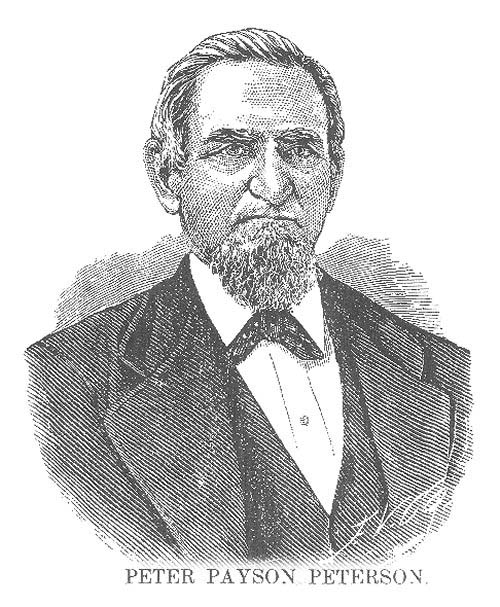

![]()

![]()
The subject of this sketch is a native of Tondern, Germany, in the Duchy of Schleswig, where he was born March 13, 1825. He was the third son of Peter P. and Helena Catharina Peterson. Young Peter was sent to school at an early age, and when thirteen years old entered the high school, where he acquired the rudiments of the higher branches of learning. He was of a wild and reckless disposition that chafed under the restraints of school, and at the age of fifteen abandoned his school and other advantages and entered the commercial marine service. He sailed from Bremen as ship boy, ordinary seaman and able-bodied seaman for four years, visiting the ports of the Baltic and North seas and several times crossing the Atlantic. In 1844 he was induced to leave his ship in New Orleans and engage in the American service, there being better prospects for advancement. He eagerly grasped every opportunity on the voyage to learn to speak and read the English language, which he soon accomplished. In August, 1844, he sailed in a vessel loaded with cotton from Apalachicola to Liverpool. The second day out she sprang a leak that could not be overcome, a gale came up, and the captain beached the vessel on Santa Rosa island, on the gulf coast of Florida, the crew reaching shore on a raft of cotton bales. He returned to New Orleans and for three years sailed before the mast and as mate in various ships, chiefly between New York and Liverpool. Apprised of his father's death a year after it occurred, he hastened home in 1847. He then went to the Danish school of navigation at Tonning, where after a preparation of only three weeks he passed the examination and received a master's patent or diploma. He remained there that winter as assistant instructor, and in the spring of 1848 shipped in a Danish vessel for Rio de Janeiro and other ports, returning to Hamburg in the spring of 1849. He then went to Havre de Grace, and then to New York, as third mate of the American ship St. Denis, full of German and French passengers. He coasted all summer ant then shipped as seaman on the Tuscarora from Philadelphia to Liverpool. On the return voyage, with 660 passengers, they stranded about midnight in a severe storm off the Delaware coast, south of Cape Henlopen. The passengers and baggage were saved, but the poor sailors lost everything but their lives. He went to Philadelphia hatless and shoeless, where he declared his intention to become a citizen, perfecting his naturalization in August, 1851. After a few weeks he embarked in the bark Venezuela, in the trade to Venezuela. In 1850 he joined Empire Lodge, No. 104, Independent Order of Odd Fellows, of Pennsylvania. In 1851 he went as second mate on two voyages to Rio de Janeiro, and then as chief mate on the brig Calvert, from Baltimore to the Atlantic ports. He was taken sick on board and left the vessel in New York, and was for a few weeks in the Staten Island hospital. he then sailed for San Francisco in the clipper ship Golden Gate. He left New York about the first of November, passed Cape Horn about Christmas, and reached San Francisco February 3, 1853. He went up the coast to Crescent City and back to San Francisco; then to Portland, Oregon, taking on a load of lumber at St. Helens. On his return to San Francisco he left his entire sea outfit, books, papers, etc., in charge of a supposed friend, and started for the mines via Crescent City and Smith river, with little money and no experience. For two years he mined with poor success on Smith river, Sailor diggings, Jacksonville, and Cottonwood. He went from the last place in 1855 to Scott Bar, where he worked with varying success until 1872, gaining the good-will of all his neighbors. Being somewhat crippled by a sprained ankle, he resolved to become a school teacher, and prepared himself and successfully passed a rigid examination, and entered upon his new field of labor. He taught three terms at Sciad, one at Scott Bar, Franklin School of Scott valley, three terms, union District in 1879, and Cedar Park School in 1880. As a resident of the county he takes great interest in all that tends to advance the prosperity of the people. He is a member of Evening Star Lodge, No. 186, Free and Accepted Masons, at Etna.
![]()
The above picture and text are from: History of Siskiyou County, Harry L. Wells, D. J. Stewart & Co., 1881; pg. 156B
![]()
Peter Payson Peterson is buried in Scott Bar Cemetery
Copyright February 16, 2002
Siskiyou Cemeteries Online
No part of this document may be reproduced for sale or for inclusion in a collection for sale.